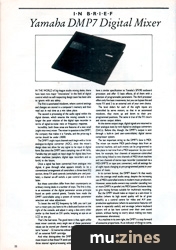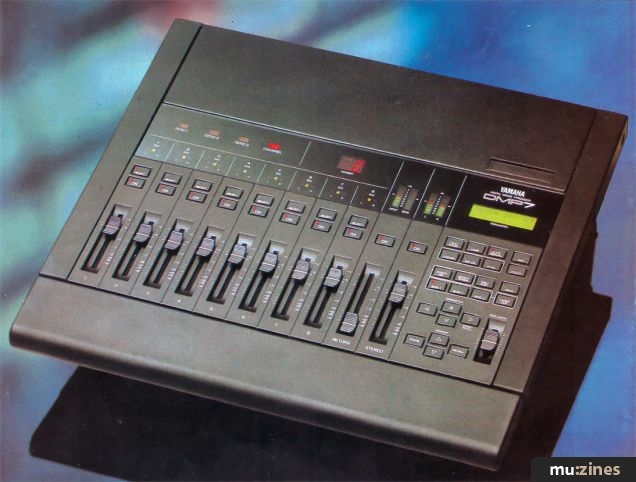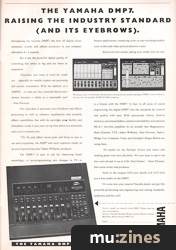Magazine Archive
Home -> Magazines -> Issues -> Articles in this issue -> View
Yamaha DMP7 Mixer | |
Article from Music Technology, February 1987 | |
Just weeks before it makes its European debut, Dan Goldstein previews the small mixing console that could change the way we think about signal processing, sequencing, and recording as a whole.

IN THE WORLD of big-league studio mixing desks, there have been two major "innovations" in the field of digital control which no self-respecting design team has been able to ignore with any safety.
The first is automated mixdown, where control settings and changes are stored in a computer's memory and then read out in real time as a mix takes place.
The second is processing of the audio signal within the digital domain, which ensures the mixing console is no longer the poor relation of the digital tape recorder in terms of signal-to-noise ratio or frequency response.
Incredibly, both these areas are features of a new small (eight-into-two) mixer. The mixer in question is the DMP7, the company that makes it is Yamaha, and the price-tag it carries should be under £4000.
The DMP7's eight input channels each begin with a 16-bit analogue-to-digital converter (ADC), since the mixer's design does not allow for any signal to be input in digital form. But since the DMP7 uses a sampling rate of 44.1 kHz, Yamaha may yet supply an input stage for digital data from other machines (samplers, digital tape recorders and so forth) in the future.
Once a signal has been converted from analogue into digital, it goes through what appears initially to be a conventional arrangement of controllers: a three-band EQ section, three FX send controls (switchable pre- and post-fade), a channel on-off switch, a pan control and a level fader.
But these controllers differ from their counterparts on ordinary mixing desks in a number of ways. The first is that, in an extension of the digital parameter access principle found on synth control panels, Yamaha have made the DMP7 controllable using a system of remote parameter selection and value adjustment.
To boost the mid EQ frequency by 5dB, you can't just turn a rotary pot, you have to hit a dedicated button on the right of the console, and adjust it using a data entry slider similar to that found on DX synths, keeping an eye on an LCD as you go.
That's the bad news. The good news is that, again unlike most mixer controls, every single one of these parameter values can be stored per channel as part of what Yamaha term "scenes" - 32 memories onboard the DMP7, a further 67 on external RAM cartridge.
And what distinguishes the DMP7 even further from most mixers is that those FX send controls can be routed to three internal signal-processing units. Two of these units have a similar specification to Yamaha's SPX90 outboard processor, and offer 15 basic effects, all of them with a selection of programmable parameters. The third processor offers only five basic treatments, but you can bypass this and route FX send 3 to an external unit of your own choice.
The level sliders for each of the eight inputs are controlled by servo motors, so that in an automated mixdown, they move up and down to their pre-programmed positions. The same is true of the FX return and stereo output sliders.
At the stereo output stage, digital signals are returned to their analogue state by twin digital-to-analogue converters (DACs). Before this, though, the DMP7's output is sent through a built-in (and user-controllable) digital stereo compressor system.
The last important string to the DMP7's bow is MIDI. The mixer can receive MIDI patch-change data from an external machine, and such events can be programmed to take place in real time from a MIDI sequencer. So you could have, for example, four channels of sequencer-controlled synths being linked to two channels of MIDI drum machine and two channels of stereo tape recorder (connected via a MIDI-SMPTE or tape sync converter), with all settings for all eight inputs changing at pre-programmed points in your piece of music.
In its current format, the DMP7 doesn't fit that neatly into the average small studio setup, despite the increasing use of MIDI-controlled events in modern music production. However, some studio owners may consider cascading two or more DMP7s in parallel (via MIDI System Exclusive data) to give mixing formats suitable for multitrack recording.
But the DMP7 should make an impact as a sub-mixer in studios (where its high sound quality will be of great benefit); as a control centre for video and A/V post-production applications (where its automation features will come in especially useful); and on-stage (where keyboard players will at last have control over their own sound system, without having to worry about making too many spontaneous alterations).
As a machine in its own right, the DMP7 is a step forward of awesome proportions. As an indicator of things to come, its impact could be phenomenal.
(Contact Details)
Also featuring gear in this article
Featuring related gear
Publisher: Music Technology - Music Maker Publications (UK), Future Publishing.
The current copyright owner/s of this content may differ from the originally published copyright notice.
More details on copyright ownership...
Preview by Dan Goldstein
Help Support The Things You Love
mu:zines is the result of thousands of hours of effort, and will require many thousands more going forward to reach our goals of getting all this content online.
If you value this resource, you can support this project - it really helps!
Donations for October 2025
Issues donated this month: 0
New issues that have been donated or scanned for us this month.
Funds donated this month: £0.00
All donations and support are gratefully appreciated - thank you.
Magazines Needed - Can You Help?
Do you have any of these magazine issues?
If so, and you can donate, lend or scan them to help complete our archive, please get in touch via the Contribute page - thanks!






